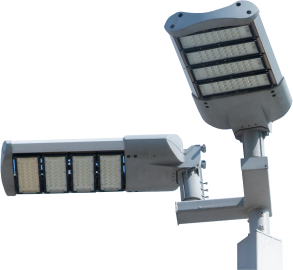STREET
LIGHT SERIES
Street LED Lighting System refers to the infrastructure used to illuminate streets, roads, and public spaces with energy-efficient LED (Light Emitting Diode) technology. These systems are increasingly being adopted worldwide due to their benefits, such as lower energy consumption, longer lifespan, and enhanced light quality compared to traditional street lighting technologies like sodium vapor or halogen lamps.
Key Features and Components of a Street LED Lighting System

LED Fixtures:
- The main light source in the system. LEDs are energy-efficient, durable, and provide bright, uniform light.
- They are often mounted on poles and are designed to withstand environmental factors such as rain, wind, and extreme temperatures.

Poles and Mounting Hardware
- Street lights are mounted on poles that can vary in height based on the street or area being illuminated. The poles are made of materials like steel, aluminum, or concrete.
- These poles also house electrical wiring and may have other funct ties, such as being part of a smart city infrastructure.

Photocells:
- Photocells are sensors that detect light levels and automatically turn the lights on at dusk and off at dawn, ensuring efficient use of energy.

Dimming and Smart Controls
- Some modern LED systems incorporate dimming capabilities, which can reduce the brightness at certain times, such as late at night when there is less traffic.
- Smart controls can allow remote monitoring and management of street lighting systems. Cities can use sensors and data analytics to optimize lighting based on traffic or pedestrian presence.

Power Supply and Distribution:
- Street lighting systems are connected to the electrical grid, but in some cases, solar-powered systems are used. Solar panels on top of light poles convert sunlight into electricity, providing an environmentally friendly alternative.
- Some systems are hybrid, using both grid power and solar power

Energy Efficiency and Sustainability
- LED technology consumes far less power than traditional incandescent or halogen lights.
- LEDs also have a much longer lifespan (up to 50,000 hours or more), which reduces maintenance costs and the need for frequent replacements.
- LEDs produce less heat compared to traditional lighting systems.
Applications
Urban Streets:
Major roads and highways where high visibility is essential.
Residential Streets:
Providing general lighting for suburban neighborhoods.
Parks and Public Spaces:
Illuminating walkways, playgrounds, and recreational areas.
Smart Cities:
Integration with IoT devices and sensors to create data-driven, adaptive lighting solutions.
Advantages of Street LED Lighting Systems

Cost-Effective:
Though LED street lighting systems have a higher initial installation cost, their long lifespan and energy efficiency lead to significant savings over time. Reduced energy bills and fewer replacements make them a cost-effective solution in the long run.

Better Light Quality:
LEDs provide brighter, clearer light with better color rendering than traditional lighting technologies. They also offer better control over light distribution, reducing light pollution and energy waste.

Reduced Carbon Footprint:
Lower energy consumption and the potential use of solar-powered systems contribute to a reduction in greenhouse gas emissions, helping to combat climate change.

Enhanced Safety:
Brighter and more consistent lighting improves visibility for drivers, cyclists, and pedestrians, reducing accidents and enhancing safety.

Smart Integration:
With advanced features like motion detection, adaptive lighting, and real-time data collection, smart LED street lighting systems can dynamically adjust based on traffic patterns or public needs.
Challenges

1. High Initial Installation Cost:
– The upfront costs for purchasing and installing LED fixtures and control systems can be substantial, though this is offset by long-term savings.

2. Compatibility:
– Integrating new LED systems into existing street lighting infrastructure may require modifications or upgrades to electrical wiring and poles.

3. Light Pollution:
– If not properly designed, LED lights can contribute to light pollution, affecting ecosystems and human health. Shielding and smart controls help mitigate this issue.
Future Trends

Smart Street Lighting:
Integration with smart city systems for remote monitoring, data collection, and adaptive lighting management.

Solar-Powered LED Lighting:
Increasing use of solar panels to power street lights, reducing reliance on the electrical grid.

Color Temperature Control:
Adjusting the color temperature of the light (e.g., warmer tones for residential areas or cooler tones for commercial districts).

Energy Harvesting:
Exploring innovative methods like energy harvesting from road vibrations or wind energy to power the lights.


